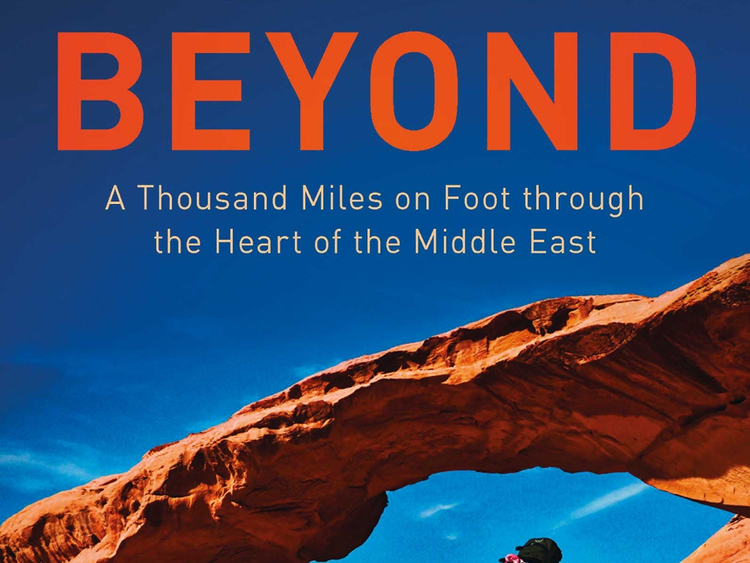By Leon McCarron, IBTauris, 288 pages, $21
“A hiker climbing a hill in the rain with his head down is unlikely to be a thief or a murderer, and the way in which they are exposing themselves to the world around them draws kindness and compassion. It is one of the many reasons to travel on foot.” Having explained himself, Leon McCarron sets off from occupied Jerusalem, taking the first of his “2 million-odd steps”.
His epic foot journey takes him to Jericho, Nablus, Jenin in the occupied West Bank, on to Amman, Petra, Wadi Rum, and Aqaba in Jordan, and culminates in Mount Sinai in Egypt.
McCarron, a Northern Irish writer, filmmaker and speaker is not new to this sort of thing. He is a Fellow of the Royal Geographical Society, and specialises in long-distance, “human-powered” expeditions. Prior to his Middle Eastern adventure, he has cycled from New York to Hong Kong, walked 4,800kms across China, trekked 1,600kmsthrough the Rub Al Khali (the Empty Quarter) in the Arabian peninsula, and travelled along Iran’s longest river. And yes, he also rode a horse across Argentina, following the Santa Cruz River in the footsteps of Charles Darwin.
In the occupied West Bank, McCarron travels along a series of ancient walking trails, which once constituted trade and pilgrimage routes. As he chugs along, McCarron also gives the reader a lesson in the modern geopolitics of the region, through the people he encounters along the way. “You are British?” a lanky teenager enquires of him. When McCarron replies in the affirmative, the boy retorts: “Ah, you gave away our country.”
Alas, though McCarron clearly sympathises with Palestinians living under Israeli occupation in the West Bank, he doesn’t seem to fully appreciate the scale of the injustice that has befallen them.
At the time of his travels in the occupied West Bank, tensions are particularly high, with ongoing Palestinian knife attacks against the occupation army, and typically Israeli heavy-handed retaliation. One Palestinian man confides in McCarron that they can’t even put their hands in their pockets to reach for a mobile phone, in case it is mistaken for reaching for a knife. McCarron clearly gives us the Palestinian perspective of the situation. But when he follows it up with the Israeli version, in which heavily armed soldiers of an occupation force, “with body armour and … M-16 assault rifles” appear “nervous, and it was hard to blame them”, he falls into the trap of blaming both sides equally. There doesn’t seem to the appreciation that one side is the occupier, and the other, the occupied. One side is armed to the teeth, and the other side has knives and stones.
One of the more interesting people and communities he encounters in this ancient land are the Samaritans, who have always lived in this land, and are not Muslim, Christian or Jewish. With names like Anwar Cohen, they carry both Israeli passports and Palestinian IDs. With a few hundred souls, it’s one of the world’s tiniest religious communities, and is gradually dying out.
In Jordan, he enjoys the wonders of Petra and the awe-inspiring landscapes of the deserts and the canyons. His encounters with the Bedouin of Petra and his description of Bedouin society will be instantly recognisable to any reader who has spent time there. He visits the ruins of Hellenic citadels and treks through the vastness of Wadi Rum, with his Jordanian sojourn culminating in Aqaba on the Red Sea.
In light of shocking recent events in Northern Sinai, McCarron’s rapid post-9/11 history of the Egyptian region provides some background for those trying to make sense of it all. And his hike through this arid, little-understood region is one of the most gripping parts of this book.
The rewards of taking this 1,600kms journey by foot are clear to see: He wouldn’t have met the same people and wouldn’t have explored the same landscapes and societies had he driven across the Holy Land. And the book would not have been the same. Also, McCarron has a conversational, engaging writing style; as you read the book, you get the feeling that you are walking alongside him.
At its heart, this very readable book is about the people McCarron encounters in his remarkable journey. As he puts it, “In my head, I was building up a map of the journey, but one that was not based on landmarks; instead, I had a representation of the walk through faces, conversations and acts of kindness.”










